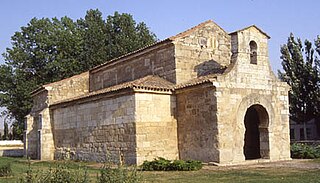
Celanova is a municipality in the province of Ourense, in the autonomous community of Galicia, Spain. It belongs to the comarca of Terra de Celanova. Situated near the border with Portugal, the municipality is bordered by Ramirás, Cartelle, A Merca, A Bola, Verea and Quintela de Leirado.

Guadix is a city and municipality in southern Spain, in the province of Granada.

The Visigoths entered Hispania in 415 and they rose to be the dominant people there until the Umayyad conquest of Hispania of 711 brought their kingdom to an end.

Abla is a municipality, former bishopric and Latin Catholic titular see in Almería province, in Andalusia, southeast Spain.

Rairiz de Veiga is a municipality in the province of Ourense, in the autonomous community of Galicia, Spain. It belongs to the comarca of A Limia.

The designation artede (la) repoblación was first proposed by José Camón Aznar in 1949 to replace the term Mozarabic as applied to certain works of architecture from the Christian kingdoms of northern Spain between the end of the 9th and beginning of the 11th centuries. Camón argued that these buildings were related stylistically to the architecture of Asturias and owed little to Andalusian styles. Moreover, since they were built by Christians living under Christian rule, neither were they Mozarabic.

Saint Rudesind was a Galician bishop and abbot. He was also a regional administrator and military leader under his kinsmen, the Kings of León.

The Diocese of Guadix is a Latin suffragan diocese of the Catholic Church in the ecclesiastical province of Granada in Andalusia, southern Spain and a Latin titular bishopric under its Ancient name of Acci. Its cathedral episcopal see is Nuestra Señora de la Anunciación, dedicated to Our Lady of the Annunciation, in the city of Guadix, administrative province of Granada. It was commenced in 1710, on the site occupied by the principal mosque, and completed in 1796.
Bandua was a theonym used to refer to a god or goddess worshipped in Iberia by Gallaeci and Lusitanians. Whether the name referred to a discrete deity or was an epithet applied to different deities is arguable.
Saint Indaletius is venerated as the patron saint of Almería, Spain. Tradition makes him a Christian missionary of the 1st century, during the Apostolic Age. He evangelized the town of Urci, near the present-day city of Almería, and became its first bishop. He may have been martyred at Urci.

According to Christian tradition, the Seven Apostolic Men were seven Christian clerics ordained in Rome by Saints Peter and Paul and sent to evangelize Spain. This group includes Torquatus, Caecilius, Ctesiphon, Euphrasius, Indaletius, Hesychius, and Secundius.

Saint Hesychius is venerated as the patron saint of Cazorla, Spain.

The monastery of San Salvador de Celanova is a religious complex in Celanova, Galicia, Spain. The once wealthy abbey of Benedictines was founded by St. Rudesind in 936. The jewel of the complex is the small Mozarabic chapel of San Miguel, dating from 942. It is located near Allariz and 14 miles (23 km) from Ourense. In the garden is one of the oldest chapels in Spain, built before 973.

Saint Caecilius is venerated as the patron saint of Granada, Spain.

Saint Secundus or Secundius is venerated as a Christian missionary and martyr of the 1st century, during the Apostolic Age. He evangelized the town of Abula, which has been identified as either Abla or Ávila, and became its first bishop.
Pelayo Rodríguez was the Bishop of Iria Flavia (977–985). He was a son of the powerful magnate Rodrigo Velázquez and his wife Adosinda and is usually associated with the conflicts surrounding the accession of Vermudo II after a Galician rebellion in 982.

Guadix Cathedral, Cathedral of Guadix, or Cathedral of the Incarnation is a Roman Catholic church in Guadix, province of Granada, Spain. Construction of the building began in the 16th century and was completed in the mid-18th century. It is in the Baroque style.

Saint Euphrasius of Illiturgis is venerated as a Christian missionary of the 1st century, during the Apostolic Age. Euphrasius’ diocese was traditionally associated with Illiturgis (Iliturgi), located between Bailén and Andújar. He is said to have been martyred at Illiturgis. According to tradition, he is one of the group of Seven Apostolic Men, seven Christian clerics ordained in Rome by Saints Peter and Paul and sent to evangelize Spain. Besides Euphrasius, this group includes Sts. Hesychius, Ctesiphon, Torquatus, Indaletius, and Secundius.

The Monastery of Benevívere was an Abbey in Spain, famous in the 12th century, now ruined. It is about 4.8 kilometres (3.0 mi) west of Carrión de los Condes in the Province of Palencia.
















